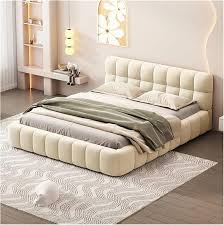Bed Frame Pricing Trends in the U.S.: What to Expect in 2025

As we approach 2025, the U.S. furniture market is gearing up for notable shifts, especially when it comes to bed frame pricing. The bed frame—a cornerstone of any bedroom setup—is no longer just a functional piece of furniture. It’s a statement of style, a symbol of comfort, and, increasingly, a reflection of consumer values such as sustainability and craftsmanship. But if you’ve been furniture shopping recently, you’ve probably noticed that prices are all over the map.
Whether you’re shopping online, visiting showrooms, or comparing across brands, understanding the factors driving bed frame prices in the U.S. is key to making an informed purchase. Over the past few years, supply chain disruptions, raw material costs, labor shortages, and shifting consumer preferences have all played a role in price trends. As we move toward 2025, the question many shoppers are asking is: should we expect prices to continue rising, stabilize, or even drop? By diving deep into the Beds price in United States landscape, we can help you prepare for what’s ahead.
The Impact of Materials on 2025 Pricing
Materials are one of the most influential factors shaping bed frame prices. Solid hardwood bed frames, which used to dominate the mid-to-high-end market, are seeing cost increases due to rising lumber prices and the push for sustainably harvested wood. Expect to see bed frames made from engineered wood, bamboo, and metal alloys gain more traction in 2025 as consumers look for affordable alternatives that don’t compromise on style.
On the luxury end, upholstered bed frames with leather, velvet, or handwoven fabrics will likely continue to command premium prices. However, manufacturers are also experimenting with eco-friendly and recycled materials, which might offer more competitive pricing. Innovations in material sourcing, particularly the use of recycled steel and sustainable textiles, are anticipated to open up a mid-range pricing tier that balances luxury appeal with environmental responsibility.
Supply Chain and Manufacturing Shifts
Global supply chains have been a major influence on bed frame pricing over the past few years. From factory shutdowns to transportation bottlenecks, disruptions have led to higher costs that manufacturers often pass on to consumers. In 2025, however, experts predict a gradual easing of these challenges. Domestic manufacturing is on the rise, with many brands investing in local production facilities to cut shipping times and reduce dependency on international suppliers.
What does this mean for you? U.S.-made bed frames might become more competitively priced as brands cut logistics costs. Additionally, the increased use of automation and precision manufacturing technologies can help streamline production processes, resulting in fewer defects and lower prices over time. While we may not see prices drop dramatically overnight, the trend points toward more stable and predictable pricing for consumers.
Style Trends and Their Pricing Impact
Design trends also play a role in bed frame pricing. Minimalist and modern designs, which use fewer materials and simpler forms, often cost less than ornate, carved, or tufted models. As younger consumers lean toward minimalism and multifunctional furniture, brands are shifting their offerings to meet these preferences. This might result in more affordable options on the market in 2025.
However, for those drawn to bespoke or handcrafted bed frames, prices are likely to rise. Artisanal pieces, especially those made with custom finishes or rare materials, will continue to command premium pricing due to the labor-intensive processes involved. The good news is that the growing direct-to-consumer (DTC) model is making designer furniture more accessible by cutting out middlemen and offering customizable options at fairer prices.
Sustainability and Ethical Production: A Premium You Might Pay
Another key factor shaping bed frame prices is the increasing consumer demand for sustainability and ethical production. Shoppers are no longer just looking for a stylish or sturdy frame—they want assurance that their purchase supports fair labor practices and minimizes environmental harm. While sustainable and ethically sourced products often come with a higher price tag, the added cost reflects not only better materials but also responsible manufacturing.
In 2025, we can expect more brands to introduce eco-friendly lines, providing a wider range of price points for consumers who prioritize sustainability. This also creates room for competition, which could bring down the cost of ethically made bed frames compared to previous years.
Comparing Beds prices in United States: Budget vs. Premium
Looking at beds prices in United States, the landscape in 2025 is shaping up like this:
- Budget-Friendly Bed Frames ($150–$500): Expect these to remain fairly stable, with options often made of particleboard, basic metals, or MDF. Quality can vary, so it’s essential to research brands and reviews before purchasing.
- Mid-Range Bed Frames ($500–$1,500): This range will see the most innovation, with engineered wood, mixed materials, and modular designs becoming more common. Expect more customization options and sustainable choices without the luxury price tag.
- Luxury Bed Frames ($1,500–$5,000+): Prices will likely continue to rise slightly due to bespoke craftsmanship, rare materials, and artisanal techniques. However, direct-to-consumer brands are helping bring some luxury designs closer to the mid-range market.
Overall, 2025 promises a wider spectrum of options across all budgets, thanks to both technological advances and shifting consumer demands.
FAQs
Will bed frame prices go down in 2025?
While we may not see dramatic price drops, experts predict stabilization and slightly lower prices in some categories due to improved supply chains and domestic manufacturing. Budget and mid-range options are likely to become more competitive.
Are U.S.-made bed frames cheaper or more expensive?
Currently, U.S.-made frames tend to cost more due to labor expenses. However, as local production becomes more efficient and scalable, we can expect more reasonably priced domestic options in 2025.
Is it worth paying extra for a sustainable or ethically made bed frame?
For many consumers, yes. While these frames can cost more, they often deliver superior quality, better longevity, and peace of mind knowing you’re supporting responsible practices.
What is the average lifespan of a good bed frame?
A well-made bed frame typically lasts 10 to 20 years, depending on the materials and usage. Investing in quality now can save money over time by reducing the need for replacements.
How can I find the best deals on bed frames in 2025?
Keep an eye on DTC brands, which often offer better prices by selling directly to consumers. Shopping during major sales events like Memorial Day, Labor Day, or Black Friday can also lead to significant savings.
Conclusion
As we move into 2025, the U.S. bed frame market offers exciting opportunities for shoppers across all price points. Whether you’re prioritizing budget, style, sustainability, or luxury, understanding the forces shaping prices can help you make smarter buying decisions. By staying informed about material trends, manufacturing shifts, and evolving consumer preferences, you’ll be well-positioned to find the best value for your money.
For those seeking top-tier style and value, My Signature Home Furniture is one of the best places for the lowest beds prices in United States. With carefully curated collections that balance design, quality, and affordability, My Signature Home Furniture is your go-to destination for creating a bedroom you’ll love for years to come.
For more info visit us:https://bazariyo.shop/



